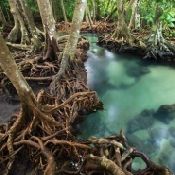Green Climate Fund Accreditation Sends Positive Signals For Nature Based Solutions
The Green Climate Fund gave nature-based solutions a potential boost when it listed IUCN, a big celebrator of leveraging nature to mitigate and adapt to climate change, as a partner organization with authority to implement climate projects. As IUCN places an emphasis on adapting to climate impacts, the announcement has implications for utilizing these natural solutions for adaptation purposes.

28 April 2016 | The International Union for Conservation of Nature (IUCN) is a well-known champion for nature-based solutions, the natural and green infrastructure that leverages ecosystems to both mitigate and adapt to a changing climate. IUCN pioneered this nature-based solution concept at United Nations climate talks, and last month, the Green Climate Fund (GCF) potentially opened up a door of opportunity to scale up their use when it labeled the union an Accredited Entity to the fund.
This accreditation further underlines the important role that nature-based solutions play in mitigation of and adaptation to climate change, IUCN said in a statement.
The GCF is a financial arm of the UN created to facilitate the flow of developed country finance to climate mitigation and adaptation activities in developing nations already struggling under climate impacts. As an accredited institution, IUCN will work with recipient countries to access GCF funding and ensure these developing regions are conversant with the GCF process. IUCN will also implement new initiatives with GCF support.
The international community expects the GCF to become the main global source of finance for tackling climate change as developed nations have agreed to move USD $100 billion annually by 2020 into the fund. And building partnerships with entities and organizations will help scale-up and strengthen the project’s pipeline, a key objective for 2016, a GCF press release said.
In terms of the GCF’s work with IUCN, it will likely focus mainly on climate adaptation measures, says Jean-Yves Pirot, Director of IUCN’s Global Environment Facility (and now GCF) Unit.
“As half of the IUCN project portfolio is adaptation projects, it seemed logical that we decided to seek accreditation. We see the GCF as an instrument that can support this portfolio well,” he says.
IUCN received accreditation only four weeks ago, so it’s still very much in early stages. “We’re still learning the ropes,” Pirot says. Though, this accreditation does appear to be another meaningful step forward for nature-based solutions. In 2014, IUCN received accreditation through the Global Environment Facility, another financing mechanism for climate and environmental finance, where it has been championing nature-based solutions.
And IUCN does have plans to establish GCF-supported projects in Africa, Asia and Central America and is looking closely at reforestation and mangroves restoration.
“We’re looking at our best performing projects in our best performing offices to construct something for the GCF,” he says.
IUCN also plans to work closely with the GCF Readiness Programme, which aids developing countries in preparing to access, manage and deploy climate finance. The Readiness Programme’s focus is on capacity building, a key principle of IUCN’s and so a good initiative on which to collaborate, Pirot says. Plus, he says it will build and strengthen government relationships, which should come in handy when attempting to implement projects down the road. The initial plan is to work the readiness angle in 10 countries.
This is the plan thus far, though Pirot says it could easily change. Whatever the changes though, Pirot is certain it will mobilize activity.
“Check back in six months,” he says. “I will probably have more exciting things to say about IUCN’s partnership with the GCF.”
Please see our Reprint Guidelines for details on republishing our articles.

